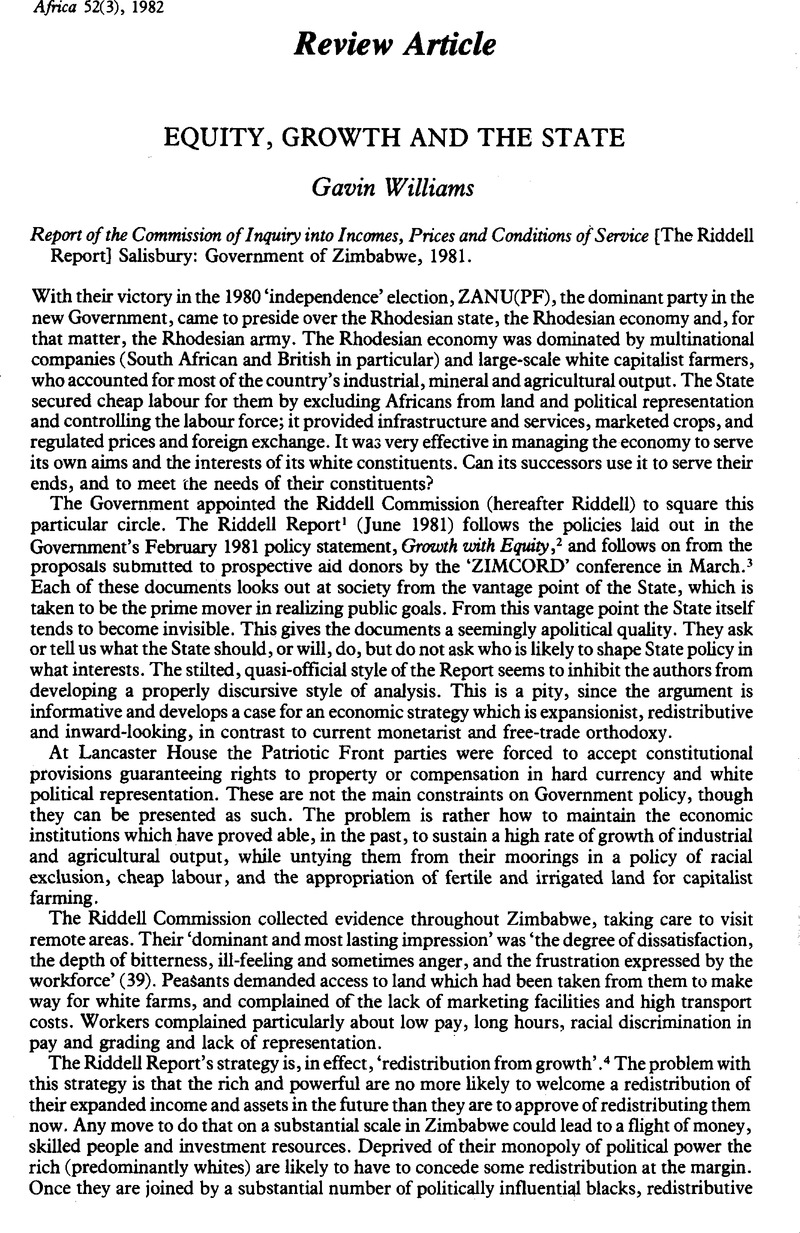Article contents
Equity, Growth and the State
Published online by Cambridge University Press: 07 December 2011
Abstract

- Type
- Review Article
- Information
- Copyright
- Copyright © International African Institute 1982
References
Notes
1 Unless otherwise specified all references are to the paragraphs of this report.
2 Government of the Republic of Zimbabwe, Growth with Equity: an economic policy statement Cmd. R.Z. 4–1981.
3 Zimbabwe Conference on Reconstruction and Development: Conference Documentation, Salisbury 23–27 March 1981.Google Scholar
4 This strategy was outlined in the International Labour Office and taken up by the World Bank in H. Chenery et al. (eds.) Redistribution with Growth. See critique of the strategy by Weeks, J. F. in Oxaal, I. et al. (eds.) Beyond the Sociology of Development (London, 1975).Google Scholar
5 Put forward, notably, by the Anglo-American group (Riddell, 166).
6 Roger Riddell criticized this ‘far tighter squeeze,’ arguing that it will lead to an exodus from the public to the private sector and greater movement between jobs in the private sector. Cited in Jenny Barrell, ‘Zimbabwe's wage increases: “too much” but “not enough” ’, African Business 42, February 1982.
7 For Nigeria, see Williams, G. ‘Inequalities in rural Nigeria’. Occasional Paper, School of Development Studies, University of East Anglia, 1982, pp. 19–24, 85–7.Google Scholar
8 Heyer, J., ‘Agricultural development policy in Kenya from the colonial period to 1975’, in Heyer, J. et al. , (eds.) Rural Development in Tropical Africa, London: Macmillan 1981, p. 110CrossRefGoogle Scholar; Njonjo, Apollo L. ‘The Kenya peasantry: a re-assessment’, Review of African Political Economy, 20 (1981), pp. 27–40.CrossRefGoogle Scholar
9 For a comprehensive study of irrigation in the Lowveld see Mudekunye, W. H. ‘Growth and development in Zimbabwe: the role of the state and private enterprise in the Lowveld’ D. Phil, thesis, University of East Anglia, 1980.Google Scholar On Nigeria see T. Wallace, ‘The Kano River project, Nigeria: the impact of an irrigation scheme on productivity and welfare’ in Heyer et al. Rural Development, pp. 281–305, and ‘Agricultural projects and land in Northern Nigeria’, Review of African Political Economy 17 (1980), pp. 60–70.
10 See A. Coulson, ‘Agricultural policies in mainland Tanzania’ in Heyer et al., Rural Development, pp. 70–82, and in Review of African Political Economy 10 (1977), pp. 87–96Google Scholar, Bernstein, Henry ‘Notes on state and peasantry: the Tanzanian case’, Review of African Political Economy 21 (1981), pp. 44–62.CrossRefGoogle Scholar
- 4
- Cited by


